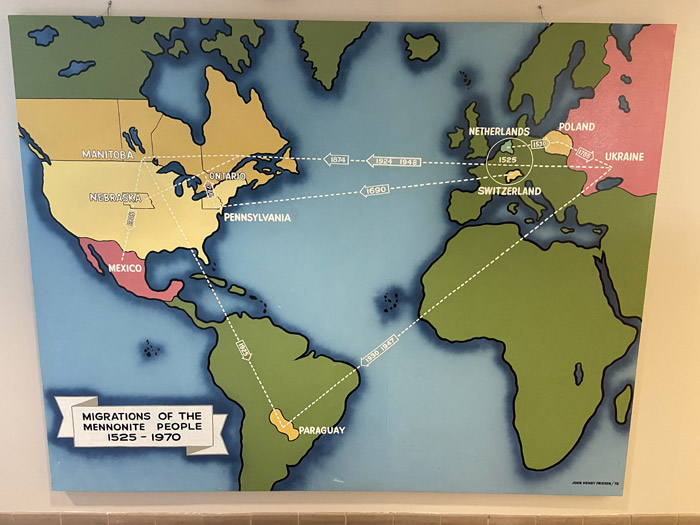At Mennonite Heritage Village (MHV), the first thing many visitors do is stop at our large migration map and see if they can determine how they arrived in Canada and what year. There are certain things every Mennonite should know, Low German phrases, Mennonite food and values, and how they came to be where they are today in Canada. The following is a clear explanation of the major Mennonite migrations over the centuries by Jake Buhler of Saskatoon. I encourage you to pass it on and discuss it with your friends and children, so that the next time they come to MHV they will know where they belong on the map.
When Mennonites fled persecution in Holland and Belgium and migrated to the Vistula Delta of Poland in the mid-1500s, they took their Dutch, Frisian, and Dutch Low Saxon dialects with them. Their spiritual leader was Menno Simons who lived from 1496 to 1561, who remained in Holland and eventually died in Germany. But in Poland, over time, Mennonites mixed in East Low German dialects learned from their Lutheran neighbours. As well, they, for the most part, worshipped in Dutch. But over the next 250 years, a Low Prussian dialect emerged that we call, today, Plautdietsch or Mennonite Low German (MLG). By the time they migrated to Russia in 1789, there was no Dutch language used – only High German (for worship) and Low German (every-day speech). Also note that by that time Prussia had taken over Poland.
In Poland, when Mennonites first settled in the Vistula Delta around 1550, they were tolerated, but not always accepted. They drained the wetlands of the Vistula Delta and became excellent dairy farmers. They learned many trades and were held up as the hardest working class in Poland. They had their own schools and kept their non-military beliefs strong. This was not always tolerated by Polish and Prussian rulers. The house-barn combination had its beginning in Poland.
In 1789, thousands of Mennonites migrated from Prussia to South Russia (today’s Ukraine) having been invited by Czarina Katharina. Mennonites thrived, and over time numbered over 100,000. They spoke their oral and unwritten Plautdietsch in their homes and High German for worship. Two dialects of Plautdietsch developed: Molotschna and Chortitza.
When Russia began to enforce Russian language study and army enlistment about 17,000 Mennonites migrated to Canada and the USA between 1874 and 1880. One group, mainly the Molotschna speakers, went to Kansas and other Midwestern states. A smaller group of Molotschna also moved to Canada. A much larger group of the Chortitza Plautdietsch speakers (Old Colony Mennonites) moved to Manitoba and settled in the East and West Reserves. In 1895 several thousand moved to the Saskatchewan District of the NWT. They settled in the Hague-Osler, and Swift Current Reserves. From there several thousand moved after 1922 to Mexico, and later to several other South American countries. In the 1920s more than 20,000 Mennonites arrived in Canada from the Soviet Union.




